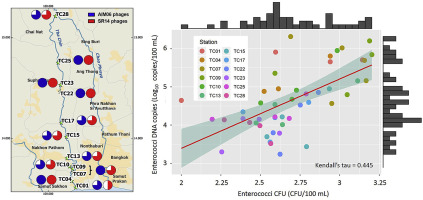International Journal of Hygiene and Environmental Health ( IF 4.5 ) Pub Date : 2020-02-19 , DOI: 10.1016/j.ijheh.2020.113482 Natcha Chyerochana 1 , Akechai Kongprajug 1 , Pornjira Somnark 2 , Pinida Leelapanang Kamphaengthong 3 , Skorn Mongkolsuk 4 , Kwanrawee Sirikanchana 4

|
The bacteriophages of E. faecalis strains AIM06 (DSM100702) and SR14 (DSM100701) have previously been validated as human-specific microbial source tracking (MST) markers in Thailand. In this study, their spatial and temporal distribution in a freshwater river was investigated for the first time (n = 48). The abundance of enterococci as a standard microbial water quality parameter was evaluated by both the qPCR detection assay with primers and a hydrolysis probe according to the US EPA Method 1611 and the US EPA Method 1600 membrane filtration culture method. AIM06 and SR14 phages were detected by a double layer agar assay and were present in 87.5% and 81.3% of all samples with a co-presence of 92.9% of phage-positive samples. After spiking the representative phages, the ranges of recovery efficiencies were 57.9–99.6% and 49.6–99.9% (n = 48) for AIM06 and SR14 phages, respectively. The absolute abundance of AIM06 and SR14 phages ranged from 0.25 to 221.94 and from 0.25 to 76.66 PFU/100 mL, respectively. Enterococci DNA copies and CFU were detected in all samples ranging from 3.24 to 6.32 log10 copies/100 mL and 100.00 to 1593 CFU/100 mL, respectively. Enterococci in the qPCR assay also showed a moderate correlation with the culture method. The AIM06 and SR14 phage results indicated continuing human faecal pollution along the river with no significant different levels among stations. Interestingly, the higher levels of enterococci in downstream stations for both the qPCR and culture methods along with the significant correlation with other faecal indicator organisms and non-human MST markers implied non-human faecal pollution. In conclusion, this study provides insightful information that could lead to effective water quality management and public health risk reduction from exposure to faecally-contaminated water.
中文翻译:

热带分水岭中肠球菌和人特异性肠球菌的分布。
粪肠球菌的噬菌体菌株AIM06(DSM100702)和SR14(DSM100701)先前已在泰国经过验证,可作为人类特异性微生物来源跟踪(MST)标记。在本研究中,首次研究了它们在淡水河中的时空分布(n = 48)。根据美国EPA方法1611和美国EPA方法1600膜过滤培养方法,使用带有引物和水解探针的qPCR检测测定法评估了作为标准微生物水质参数的肠球菌的丰度。通过双层琼脂分析检测到AIM06和SR14噬菌体,它们在所有样品中的存在率为87.5%和81.3%,共存在92.9%的噬菌体阳性样品。掺入代表性噬菌体后,AIM06和SR14噬菌体的回收效率范围分别为57.9–99.6%和49.6–99.9%(n = 48)。AIM06和SR14噬菌体的绝对丰度分别为0.25至221.94和0.25至76.66 PFU / 100 mL。在所有样品中检测到的肠球菌DNA拷贝和CFU分别为3.24至6.32 log10个拷贝/ 100 mL和100.00至1593 CFU / 100 mL。qPCR分析中的肠球菌与培养方法也显示出中等程度的相关性。AIM06和SR14噬菌体结果表明,沿河的人类粪便污染持续,各站之间的水平无明显差异。有趣的是,qPCR和培养方法下游站的肠球菌水平较高,并且与其他粪便指示生物和非人类MST标记物之间存在显着相关性,这意味着非人类粪便污染。结论,











































 京公网安备 11010802027423号
京公网安备 11010802027423号